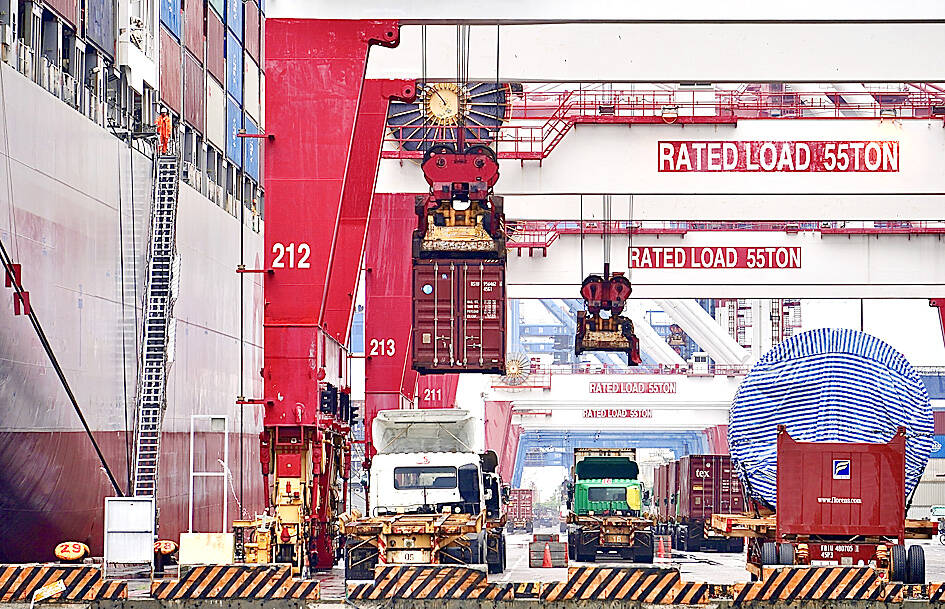Taiwan’s exports surged to an all-time high last month, powered by booming global demand for artificial intelligence (AI) and high-performance computing chips, as well as inventory stocking ahead of new consumer electronics releases, the Ministry of Finance said yesterday.
Overseas shipments rose 34.1 percent from a year earlier to US$58.49 billion, the 22nd consecutive month of growth and a new single-month record, the ministry said.
Last month’s figure also marked a symbolic milestone, as Taiwan’s export value overtook that of South Korea for the first time, it said.

Photo: CNA
South Korea’s exports slipped to US$58.4 billion last month, dragged down by weak memorychip prices, allowing Taiwan to pull ahead by US$900 million, Department of Statistics Director-General Beatrice Tsai (蔡美娜) said at a news conference in Taipei.
“The growth momentum proved surprisingly stronger than expected despite fading effects from a front-loaded buying spree triggered by earlier US tariff concerns,” Tsai said.
Taiwan has historically lagged behind South Korea in exports by about US$200 billion annually, or about US$17 billion each month, she said.
However, diverging industry trends have narrowed the gap this year, as Taiwan is benefiting from its leadership in advanced chip production, while South Korea’s export engine, long fueled by memorychips, is struggling with price declines.
The shift highlights how global trade patterns are being reshaped by the AI boom. Major US technology companies are sharply increasing orders for Taiwan-made chips and components to support data center expansion, while demand for smartphones and personal computers, once the backbone of Asian electronics exports, remains uneven.
Apple Inc was set to unveil its new iPhone 17 lineup, smartwatches and AirPods later yesterday ahead of the holiday season, which is expected to drive fresh business for Taiwanese companies across its global supply chain.
Taiwan’s exports to the US jumped 65.2 percent to US$19.63 billion last month, making the US the top export destination for the fourth consecutive month and accounting for 33.6 percent of total outbound shipments. China remained in second place with a 26 percent share.
Sales to ASEAN markets rose 46.7 percent, to Japan 34.3 percent and to China 15.9 percent. Europe was the only major market to decline, slipping 10.5 percent, partly due to tariff frictions, the ministry’s data showed.
Imports climbed 29.7 percent from a year earlier to US$41.66 billion last month, the third-highest level on record, boosted by purchases of semiconductors, information technology products and chip-making equipment. The trade surplus widened 46.3 percent to US$16.83 billion, figures that have increasingly drawn scrutiny amid trade frictions with the US, Tsai said.
With exports already up 29.2 percent year-on-year to US$398.43 billion in the first eight months of the year — already surpassing the total for all of last year — the ministry expects the momentum to be sustained.
Exports this month could expand by between 30 and 36 percent from a year earlier, Tsai said. She added that third-quarter results could beat the Directorate-General of Budget, Accounting and Statistics’ forecast by 6 to 8 percentage points, signaling potential for an upward revision to this year’s GDP growth, which currently stands at 4.45 percent.

LIMITED IMPACT: Investor confidence was likely sustained by its relatively small exposure to the Chinese market, as only less advanced chips are made in Nanjing Taiwan Semiconductor Manufacturing Co (TSMC, 台積電) saw its stock price close steady yesterday in a sign that the loss of the validated end user (VEU) status for its Nanjing, China, fab should have a mild impact on the world’s biggest contract chipmaker financially and technologically. Media reports about the waiver loss sent TSMC down 1.29 percent during the early trading session yesterday, but the stock soon regained strength and ended at NT$1,160, unchanged from Tuesday. Investors’ confidence in TSMC was likely built on its relatively small exposure to the Chinese market, as Chinese customers contributed about 9 percent to TSMC’s revenue last

With this year’s Semicon Taiwan trade show set to kick off on Wednesday, market attention has turned to the mass production of advanced packaging technologies and capacity expansion in Taiwan and the US. With traditional scaling reaching physical limits, heterogeneous integration and packaging technologies have emerged as key solutions. Surging demand for artificial intelligence (AI), high-performance computing (HPC) and high-bandwidth memory (HBM) chips has put technologies such as chip-on-wafer-on-substrate (CoWoS), integrated fan-out (InFO), system on integrated chips (SoIC), 3D IC and fan-out panel-level packaging (FOPLP) at the center of semiconductor innovation, making them a major focus at this year’s trade show, according

DEBUT: The trade show is to feature 17 national pavilions, a new high for the event, including from Canada, Costa Rica, Lithuania, Sweden and Vietnam for the first time The Semicon Taiwan trade show, which opens on Wednesday, is expected to see a new high in the number of exhibitors and visitors from around the world, said its organizer, SEMI, which has described the annual event as the “Olympics of the semiconductor industry.” SEMI, which represents companies in the electronics manufacturing and design supply chain, and touts the annual exhibition as the most influential semiconductor trade show in the world, said more than 1,200 enterprises from 56 countries are to showcase their innovations across more than 4,100 booths, and that the event could attract 100,000 visitors. This year’s event features 17

Hon Hai Precision Industry Co (鴻海精密), which assembles servers for Nvidia Corp, yesterday said that revenue last month rose 10.61 percent year-on-year, driven by strong growth in cloud and networking products amid continued front-loading orders for artificial intelligence (AI) server racks. Consolidated revenue expanded to NT$606.51 billion (US$19.81 billion) last month from NT$548.31 billion a year earlier, marking the highest ever in August, the company said in a statement. On a monthly basis, revenue was down 1.2 percent from NT$613.86 billion. Hon Hai, which is also a major iPhone assembler, added that its electronic components division saw significant revenue growth last month, boosted